Ocean Park, Santa Monica: Nestled just east of Lincoln Boulevard sits this lovely, spacious home at 1026 Cedar Street. Built in 1926, this 2-bedroom/2-bath 1,500 sq. ft. Spanish bungalow is a quiet refuge from the beach and other tourist hotspots that surround it. Just a mile from the ocean, a mile from Penmar Golf Course, and close enough to Third Street Promenade shopping, this cozy home is situated in a less-frequented part of Santa Monica–prime real estate for those who want the city’s allure without all of the city’s noise.
Los Angeles is a city teeming with port cities built on dreams of bustling maritime business, and Santa Monica was certainly among these. The city was founded in 1875 by Colonel Robert S. Baker and Senator John P. Jones, both entrepreneurs in the silver mining business who aimed to turn the city into a leading port town.
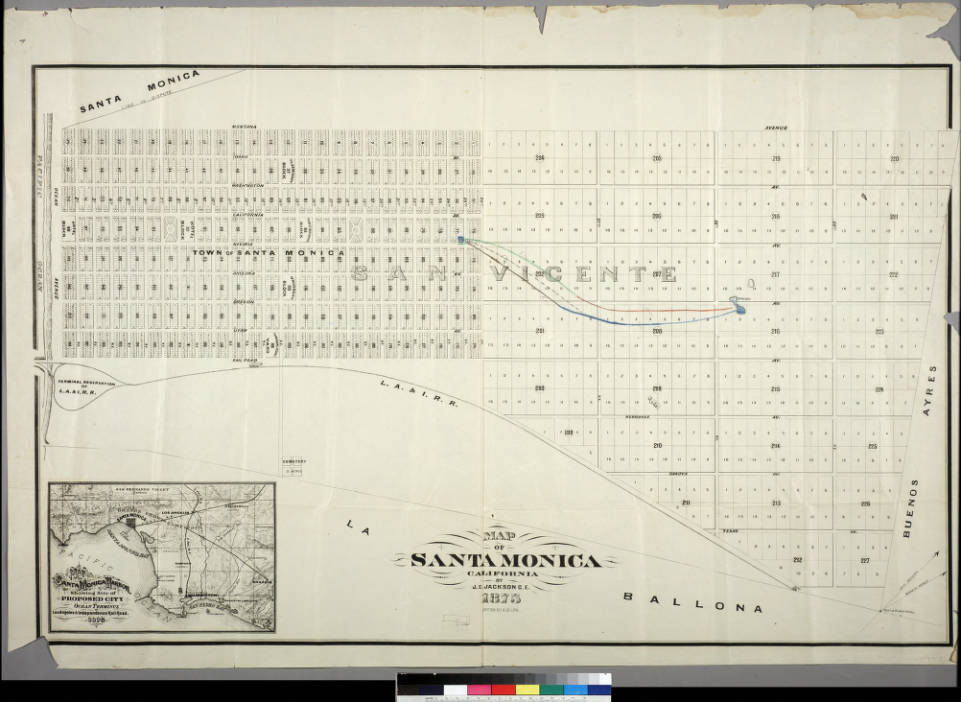
Map of Santa Monica, circa 1875, Huntington Digital Library
According to the Santa Monica Conservancy website, however, the city failed as a port city and instead drew crowds for its beaches and tourist attractions shortly after its incorporation in 1886.
One of the subdivisions that grew out of Santa Monica’s development was the Ocean Park neighborhood in South Santa Monica, quite close to where 1026 Cedar Street is located. Ocean Park, though situated within present-day Santa Monica, actually shares a closer history with Venice. In the late 1800s when Abbot Kinney established his “Venice of America” tourist attraction to be right near the ocean, he looked toward a small strip of sand dunes not far away from it for its real estate potential.

Los Angeles Herald, January 29, 1905
Kinney formed the Ocean Park Development Company and along with his partner F.G. Ryan, purchased this small strip of land and sold out parcels to help encourage building throughout the early 1900s. Soon, the sandy strip was teeming with homes and roads. Read more about Venice in our 2523 Abbot Kinney Boulevard Units #1 & 2 Blog post.
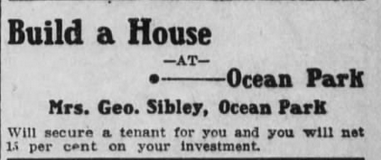
Los Angeles Herald, January 27, 1905
Later, an auditorium, piers, a public bathhouse/plunge and much more materialized in Ocean Park, drawing more visitors to this burgeoning beachside city.
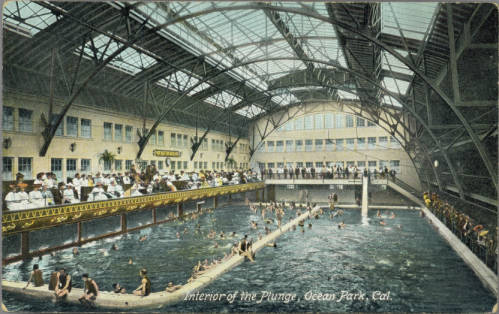
Ocean Park Plunge circa 1905, courtesy of USC Digital Libraries, USC
As the Los Angeles Pacific Railway expanded its reach and created more accessible routes for tourists to trek back and forth to this bustling part of Los Angeles, substations began popping up in subdivisions like Ocean Park.
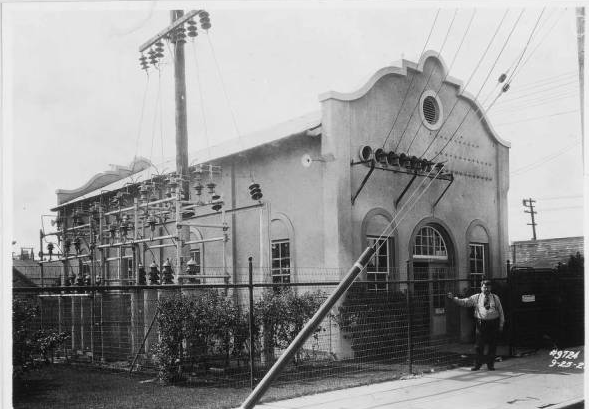
Ocean Park Substation, circa 1923, Huntington Digital Library
The former substation owned by the Los Angeles Pacific Railway was most recently the site of the Powerhouse Theater (now defunct), located at 3116 2nd Street. City of Santa Monica historical documents show that the location is under review for historical designation consideration.
Another partner of Abbot Kinney’s, Alexander Fraser, developed the Pacific Ocean Park (or POP) area near the strip with a multimillion-dollar amusement park. The park featured attractions like “Dragon Gorge Railway”—an impressive roller coaster even by today’s standards, a House of Mystery, Grotto Café, Auto Haze, and other spectacles to allure beachside tourists (Stanton).
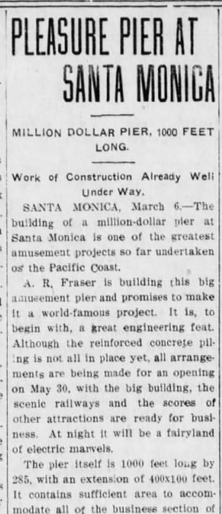
Santa Cruz Sentinel, March 7, 1911
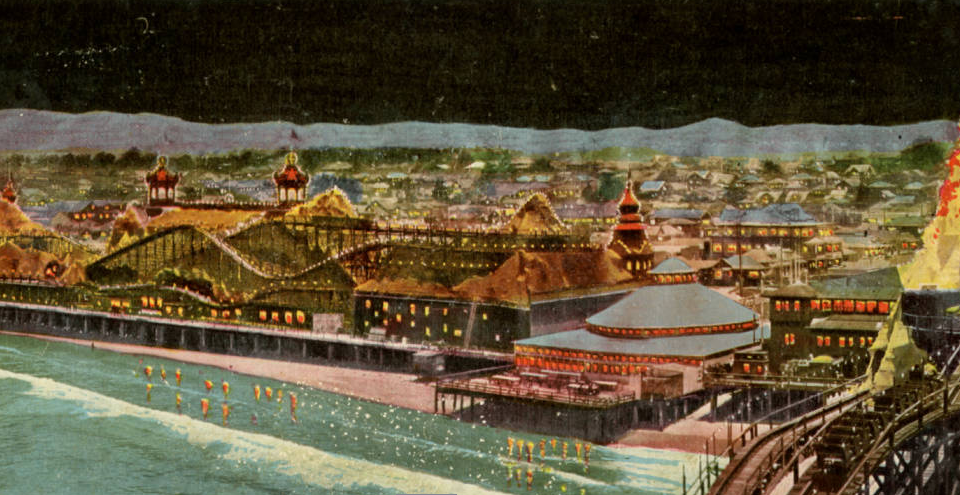
Postcard of Pacific Ocean Park Pier circa 1911, courtesy of Dept. of Archives and Special Collections, Loyola Marymount University
Charlie Chaplin’s film Number, Please, starring Hal Lloyd and Mildred Davis, contains a scene filmed at the Pier, and other notables like Douglas Fairbanks and Mary Pickford also were reputed to have visited the tourist hotspot.
Sadly, Fraser’s million-dollar project lasted all but a little over a year. On September 4, 1912, a fire engulfed the entire amusement park in flames. According to the Los Angeles Fire Department’s Historical Archives
Heading out Washington Boulevard to the beach, Eley and the four motorized companies fought heavy traffic as thousands of spectators were driving toward the awesome thick black cloud of smoke that was obscuring the setting sun. Eley arrived and all four companies were operation in less than 27 minutes after the chief engineer was called at headquarters. The long wooden pier and its many attractions – the famous observation ballroom, the Crazy House, Dragon’s Gorge and the auditorium-dance pavilion – were doomed.
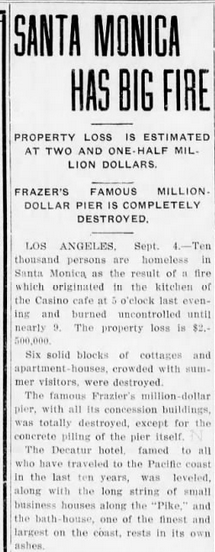
Santa Cruz Sentinel, September 4, 1912
1026 Cedar would have been just a mile away from the Ocean Park Pier in what is now known more specifically as the Sunset Park neighborhood adjacent to present day Ocean Park. Homes in the Sunset Park area are south of Pico Blvd., north of Dewey Blvd, west of Centinela Avenue, and east of Lincoln Blvd. 1026 Cedar Street was built in 1920, just eight years after the fire that ravaged Frazier’s million-dollar dream during the beachside boom. According to Santamonicalandmarks.com, homes in the Ocean Park area became more available after the Vawter Family—one of the original families to settle Pasadena, CA—moved to Santa Monica and began developing it with a sheep ranch, a general store, and more.
Several years later, more homes were built to make way for the industries that were slowly creeping into the West Side. Way before SpaceX and Snapchat, the West Side had, at one point, a booming tech industry. Donald Wills Douglas, an industrialist who’d graduated from M.I.T., founded the Douglas Aircraft company in 1921.
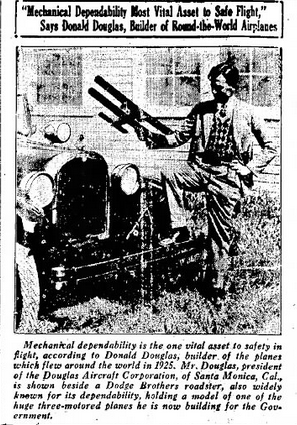
Woodland Daily Democrat, October 6, 1927
Douglas Aircraft was an aerospace outfit located in the present day Santa Monica airport area that employed many–including women—to work on its aircraft. In the 1940s during WWII, the factory drew approximately 40,000 workers specifically to the Sunset Park area.
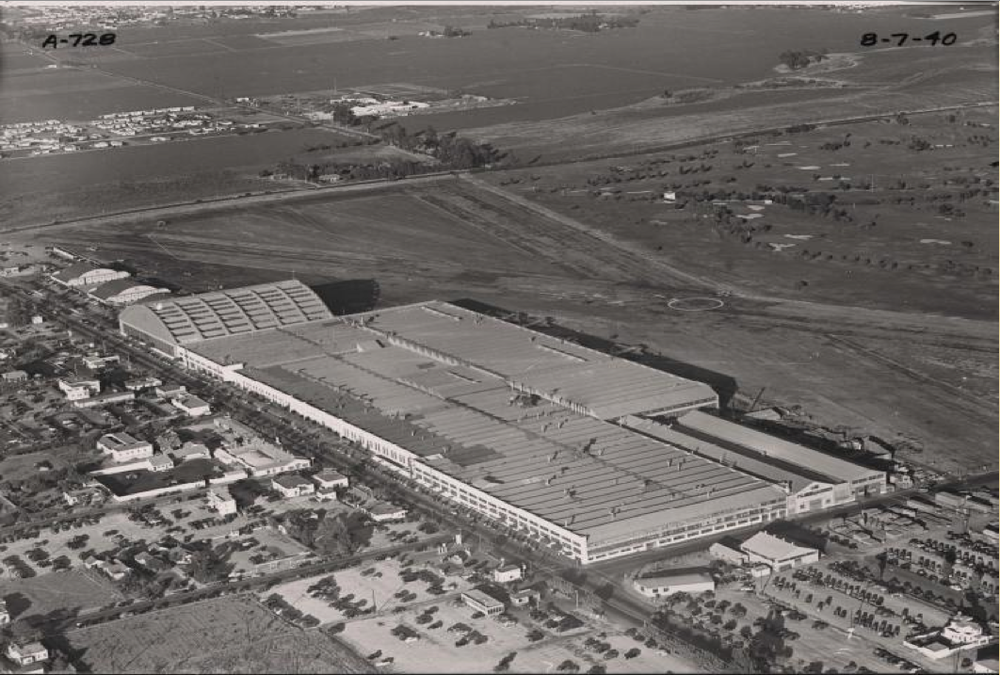
Douglas Aircraft Factory, circa 1940, courtesy of Santa Monica Airport Association
It is likely that many of the area’s homes were originally built for these workers, according to a 2003 Los Angeles Times article. Douglas would often test his crafts at the present-day Santa Monica Airport (known then as “Clover Field”), Los Angeles’ oldest airport.
Douglas’s aircraft was the first to circumnavigate the globe, a journey that took about six months. Before WWII, the famed DC-3 aircraft was debuted in 1935 and helped to make air travel more accessible, and ultimately more affordable to citizens. During WWII, Douglas Aircraft received a tremendous amount of business from the Navy, military, etc., producing bombers, fighter jets, and more.
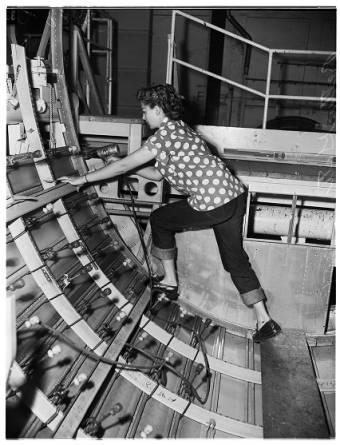
Betty Gates, hand drill operator, “Douglas Aircraft Gals” 1951, USC Digital Library
The old site of the Douglas Aircraft Factory is about 2 miles west of 1026 Cedar. Santa Monica College, less than a mile away from the home, was built just three years after the property and currently ranks as the top community college in the state. The first owners of the cozy Spanish Bungalow were a couple by the name of Omer and Minnie Van Houten. We were happy to locate their marriage announcement in an old copy of the San Bernardino News:
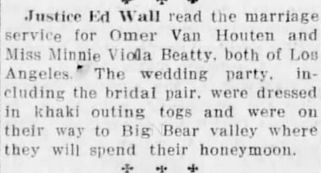
August 27, 1918 San Bernardino News
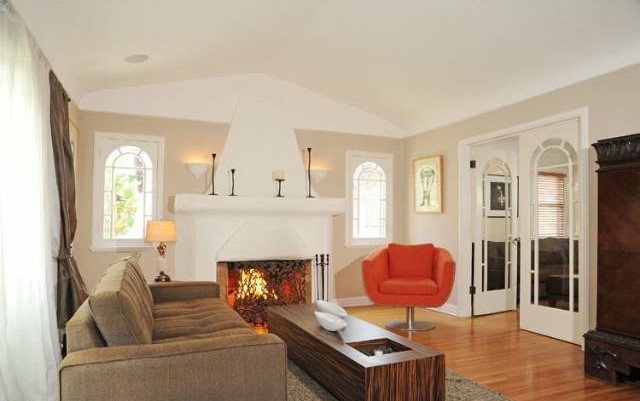
The couple moved into the home in 1926. It’s possible that this was their first home together, and lovely to imagine how they enjoyed the sunny, spacious living areas with its vaulted ceilings and (yes they are the original) French doors. Many of the original crown moldings and other details have been meticulously kept to preserve the design of the time. The breezy, open floor plan and ample sunlight combines with the coziness of a wood-burning fireplace for the ideal in beach-adjacent living.
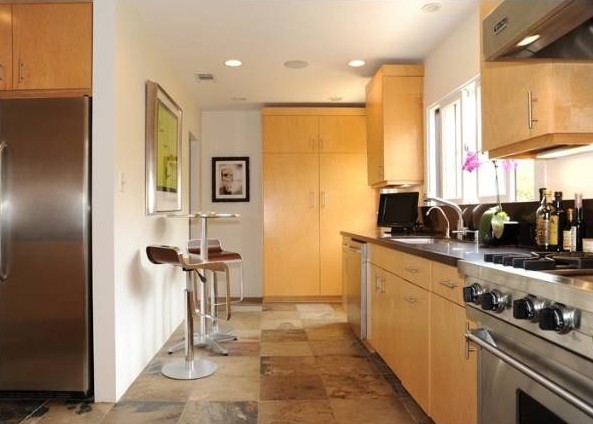
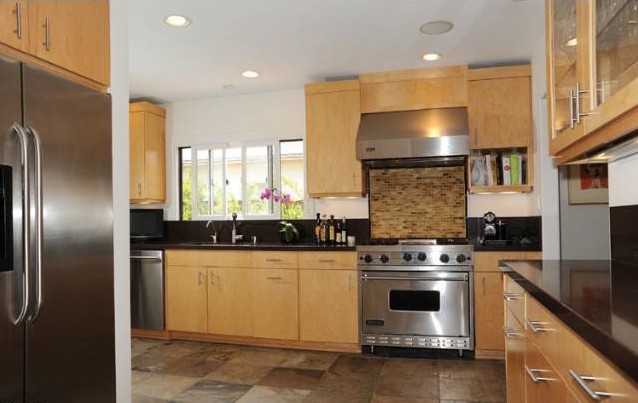
Though the property is nearly one hundred years old, the interior lends itself well to more modern, clean furnishings and design. Recessed lighting, Viking stove, beautifully redone maple cabinetry and Caesar stone countertops are nice touches too. Slate flooring and earthy tile work above the stove add luxury details without sacrificing taste.
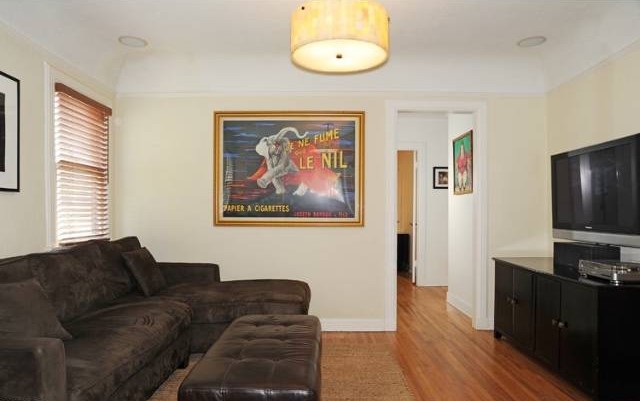
Hardwood floors throughout lead us to the comfy and simple den. In 1932, a Miss Elizabeth Ussher, a well known Santa Monica philanthropist and orphanage director, purchased the property. Perhaps she entertained foundation donors and other guests here for an after-dinner cocktail…
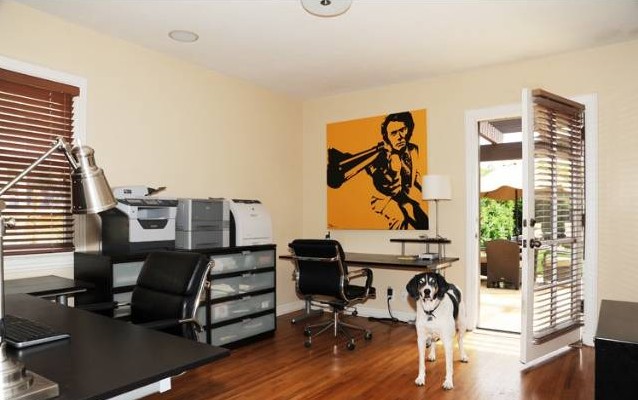
A sunny office with a French door opens up onto a back patio, where your loyal best friend awaits playtime.

Wood blinds are the perfect design element for this spacious bedroom resplendent with natural lighting. Recessed lighting and wooden furnishings add a balance between rustic and modern while maintaining the home’s original character.
Speaking of character, the home was once owned by a man who was once dubbed an “Enemy Alien.” A man named Gustav H. Wild and his wife Flora purchased the property in 1945, about thirty years after he was once accused of being a German enemy combatant and arrested.
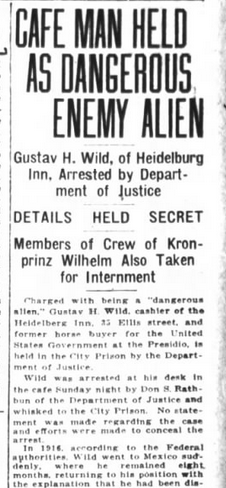
February 5, 1918 San Francisco Chronicle
Perhaps he decided that the people down here in SoCal were, well, more hospitable than its neighbors to the north…

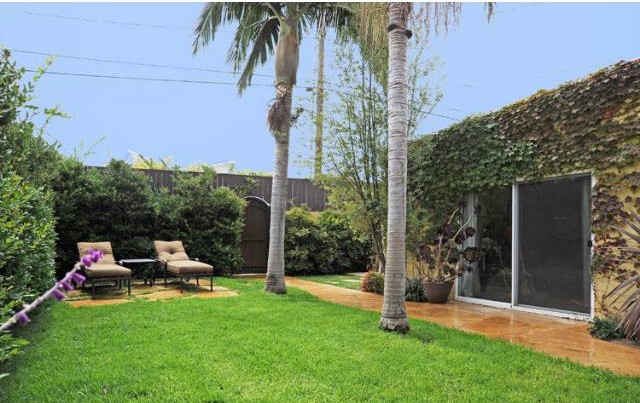
In addition to a lush, well-landscaped backyard area, the interior of the home is fitted throughout with built-in 5.1 Dolby Surround Sound speakers, making it truly an entertainer’s paradise. We’re not talking Wonderland Avenue/Laurel Canyon/Mulholland Drive/rock star to the nth degree entertaining…more like “all the good feels” that only a singer-songwriter could bring. Which it turns out, is exactly the case here. Josh Canova, the musician behind songs like “The Wish,” and “Common Divide” that have appeared on TV Shows like One Tree Hill, Alias, and Dawson’s Creek—purchased 1026 Cedar Street in 1998.
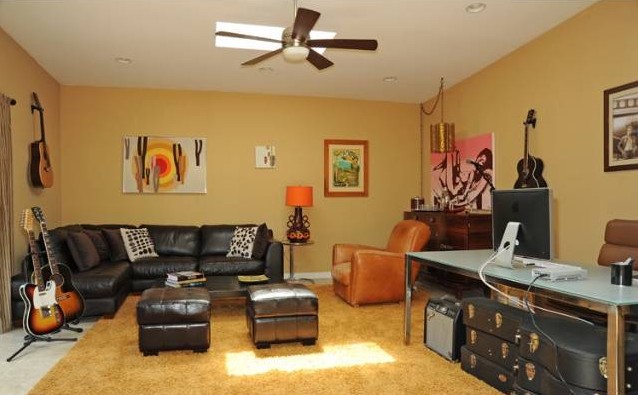
That the home was once a sanctuary for a talent like Canova is evident in the separate studio located adjacent to the home. A skylight offers abundant natural light to soothe the soul of the musician delving into the depths of love, loss, and misfortune through his or her work.

And when we say depths, we mean depths…here’s a few (approximate) lyrics off Canova’s most recent album “Adios,” from the title song:
I’m leaving you/
taking my heart too/
don’t need a plan/
where I’m going…
Adios!
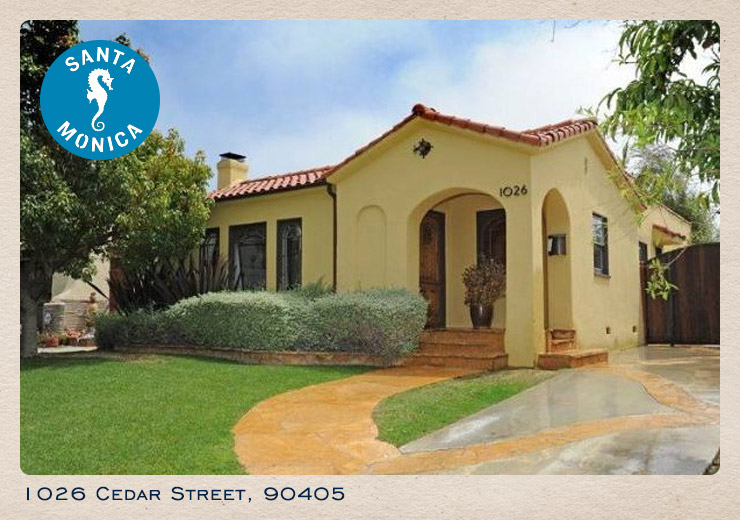
Leave a Reply
You must be logged in to post a comment.